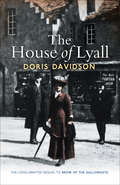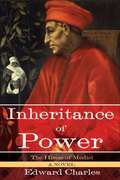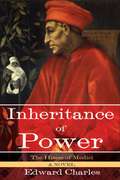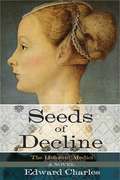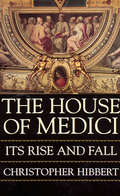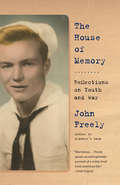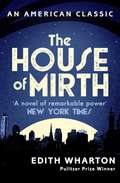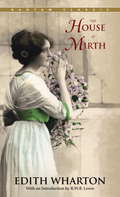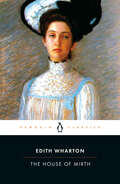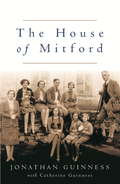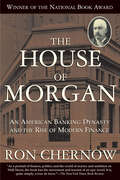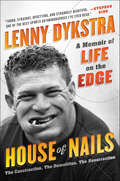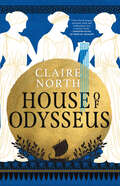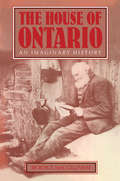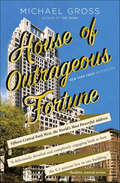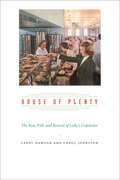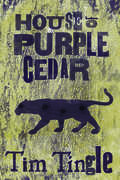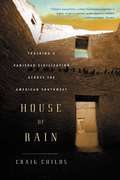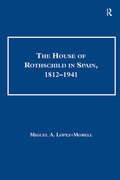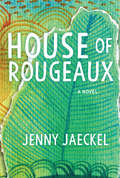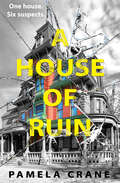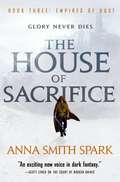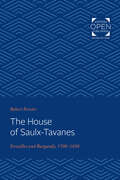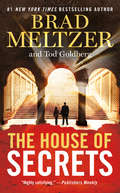- Table View
- List View
The House of Lyall
by Doris DavidsonIn this sweeping historical novel, a Scottish lady will do anything to protect her aristocratic life from the guilty secrets of her humble origins. Young and ambitious, Marion Cheyne feels trapped by her poor village roots and her lowly job as a domestic servant. So when she&’s suddenly faced with an opportunity to escape her dead-end life, she doesn&’t think twice. Absconding from her employer&’s home with more money than she&’d ever seen in her life, Marion sets out for a new life in faraway Aberdeen. Years later, the struggling servant girl Marion has become Marianne, wife of the heir to Castle Lyall, and every inch the lady of the glen. More a business arrangement than a love match, Marianne's commitment to her role and to the name of Lyall is total. As family, friends and world wars come and go, she will stop at nothing to protect her hard-won position. But the many secrets of her past refuse to stay safely buried. Nothing in the small community of the glen can remain hidden forever . . .
The House of Medici: Inheritance of Power
by Edward CharlesEver-loyal Maddalena, a diminutive, blue-eyed, black slave, has borne Cosimo de Medici a son and seen him rise to the position of cardinal. Now, late in life, she finds herself committed to a convent, as part of a scheme to protect the Medici Bank from ruin by Cosimo's sons, by hiding a fortune in gold for Cosimo's grandson, Lorenzo, to inherit. But as the months go by, and the gold does not appear, her faith in Cosimo begins to wane and with it, her confidence in her own worth. Has she been duped?Approaching old age, she finds in the abbess a confessor, to whom she can confide her true story and perhaps, at the same time, to convince herself that her life has been worthwhile. But the abbess, too, has objectives of her own, and the two of them may not be on the same side.Edward Charles presents us here with an the intrigue, glamour, wealth, and deception of Fifteenth Century Florence. One woman's devotion forms the foundation upon which the famed Medici bank was built. The largest and most respected financial institution in Europe in it's prime, it came to represent the might of the influential Medici clan, a family of great power, borne of Italy's gold; a family who scaled the very heights of human grandeur but were to suffer through one of the most catastrophic financial crashes of early banking.
The House of Medici: A Novel (The\house Of Medici Ser.)
by Edward CharlesEver-loyal Maddalena, a diminutive, blue-eyed, black slave, has borne Cosimo de' Medici a son and seen him rise to the position of cardinal. Now, late in life, she finds herself committed to a convent, as part of a scheme to protect the Medici bank from ruin by Cosimo’s sons, by hiding a fortune in gold for Cosimo’s grandson, Lorenzo, to inherit. But as the months go by, and the gold does not appear, her faith in Cosimo begins to wane, and with it, her confidence in her own worth. Has she been duped?Approaching old age, she finds in the abbess a confessor, which enables her to share her true story and perhaps, at the same time, convince herself that her life has been worthwhile. But the abbess, too, has objectives of her own, and the two of them may not be on the same side.Edward Charles presents us here with the intrigue, glamour, wealth, and deception of fifteenth-century Florence. One woman's devotion forms the foundation upon which the famed Medici bank was built. The largest and most respected financial institution in Europe in it's prime, it came to represent the might of the influential Medici clan, a family of great power, borne of Italy's gold; a family who scaled the very heights of human grandeur but was to suffer through one of the most catastrophic financial crashes of early banking.Skyhorse Publishing, as well as our Arcade, Yucca, and Good Books imprints, are proud to publish a broad range of books for readers interested in fiction-novels, novellas, political and medical thrillers, comedy, satire, historical fiction, romance, erotic and love stories, mystery, classic literature, folklore and mythology, literary classics including Shakespeare, Dumas, Wilde, Cather, and much more. While not every title we publish becomes a New York Times bestseller or a national bestseller, we are committed to books on subjects that are sometimes overlooked and to authors whose work might not otherwise find a home.
The House of Medici: Seeds of Decline
by Edward CharlesThe Riveting Sequel to The House of Medici: Inheritance of Power. Lucrezia Tornabuoni, brought up in the Palazzo Medici alongside Cosimo’s children, always expected to marry his charismatic younger son, Giovanni. But now in later life, she finds herself imprisoned in a loveless marriage with the gout-ridden elder son, Piero. Like Cosimo, she sees the future salvation of the family in the hands of her own son, Lorenzo the Magnificent, but how can she be sure he inherits the mantle before Piero ruins everything? For years she has groomed her son to be a great prince, and in the process to ignore the Medici Bank--whose wealth has funded the City and Republic of Florence. But now the economy is faltering, the money is running out, the burdens of leadership are becoming more onerous for her son, and she begins to question whether she has led him astray. Her difficulty is that in the closed society of Florence, there is no-one she can confide in. Then, while on a journey away from the city, she is approached by a young priest, Girolamo Savonarola, recently appointed to a teaching post in Florence and asking for guidance about the workings of Florentine society. In confessing the secrets of her family to this benign outsider, she is able to unburden herself of the various worries that plague her. But Savonarola may not be the simple monk he appears, his objectives proving troublesome in compatibility with Lucrezia’s as the two characters hurtle towards a thrilling and unexpected ending.
The House of Medici
by Christopher HibbertIt was a dynasty with more wealth, passion, and power than the houses of Windsor, Kennedy, and Rockefeller combined. It shaped all of Europe and controlled politics, scientists, artists, and even popes, for three hundred years. It was the house of Medici, patrons of Botticelli, Michelangelo and Galileo, benefactors who turned Florence into a global power center, and then lost it all. The House of Medici picks up where Barbara Tuchman's Hibbert delves into the lives of the Medici family, whose legacy of increasing self-indulgence and sexual dalliance eventually led to its self-destruction. With twenty-four pages of black-and-white illustrations, this timeless saga is one of Quill's strongest-selling paperbacks.
The House of Memory: Reflections on Youth and War
by John FreelyAn engaging, funny, and tender memoir from a man of ninety years: of growing up poor in a Brooklyn and Ireland that now exist only in memory, and of serving in the China/Burma/India theater during World War II as a member of an elite U.S. Navy commando unit John Freely's voice is still astonishingly youthful, full of wonder, humor, and gratitude, as he remembers his fully lived life. Born in Brooklyn to Irish immigrants, he went to Ireland with his mother when he was five, where he spent his young childhood on his grandfather's farm. Western Ireland was impoverished by the times, but rich in beauty and intriguing people, and it opened in him a lifelong desire to see the world and its inhabitants. When he was seven, he returned to Brooklyn, and the antics of a coming-of-age boy played out on streets filled with character and characters. He took whatever jobs he could when times got tough, always shaking off his losses and moving on, hungry to see and experience what was next. He joined the U.S. Navy at seventeen to "see the world," and did just that. In wartime, while bringing supplies and ammunition over the Stilwell-Burma Road to Chiang Kai-shek's Chinese guerrilla forces, Freely served alongside them during the last weeks of World War II in the Tibetan borderlands of China, a Shangri-la that war had turned into hell on earth.From the Hardcover edition.
The House of Mirth
by Edith WhartonA bestseller when it was originally published nearly a century ago, Wharton's first literary success was set amid the previously unexplored territory of fashionable, turn-of-the-century New York society, an area with which she was intimately familiar. The tragic love story reveals the destructive effects of wealth and social hypocrisy on Lily Bart, a ravishing beauty. Impoverished but well-born, Lily realizes a secure future depends on her acquiring a wealthy husband. Her downfall begins with a romantic indiscretion, intensifies with an accumulation of gambling debts, and climaxes in a maelstrom of social disasters. More a tale of social exclusion than of failed love, The House of Mirthreveals Wharton's compelling gifts as a storyteller and her clear-eyed observations of the savagery beneath the well-bred surface of high society.
The House of Mirth
by Edith WhartonAn immensely popular bestseller upon its publication in 1905, The House of Mirth was Edith Wharton's first great novel. Set among the elegant brownstones of New York City and opulent country houses like gracious Bellomont on the Hudson, the novel creates a satiric portrayal of what Wharton herself called "a society of irresponsible pleasure-seekers" with a precision comparable to that of Proust. And her brilliant and complex characterization of the doomed Lily Bart, whose stunning beauty and dependence on marriage for economic survival reduce her to a decorative object, becomes an incisive commentary on the nature and status of women in that society. From her tragic attraction to bachelor lawyer Lawrence Selden to her desperate relationship with social-climbing Rosedale, Lily is all too much a product of the world indicated by the title, a phrase taken from Ecclesiastes: "The heart of fools is in the house of mirth." For it is Lily's very specialness that threatens the elegance and fulfillment she seeks in life. Along with the author's other masterpiece, The Age of Innocence, this novel claims a place among the finest American novels of manners.
The House of Mirth
by Edith WhartonAn immensely popular bestseller upon its publication in 1905, The House of Mirth was Edith Wharton’s first great novel. Set among the elegant brownstones of New York City and opulent country houses like gracious Bellomont on the Hudson, the novel creates a satiric portrayal of what Wharton herself called “a society of irresponsible pleasure-seekers” with a precision comparable to that of Proust. And her brilliant and complex characterization of the doomed Lily Bart, whose stunning beauty and dependence on marriage for economic survival reduce her to a decorative object, becomes an incisive commentary on the nature and status of women in that society. From her tragic attraction to bachelor lawyer Lawrence Selden to her desperate relationship with social-climbing Rosedale, Lily is all too much a product of the world indicated by the title, a phrase taken from Ecclesiastes: “The heart of fools is in the house of mirth.” For it is Lily’s very specialness that threatens the elegance and fulfillment she seeks in life. Along with the author’s other masterpiece, The Age of Innocence, this novel claims a place among the finest American novels of manners.
The House of Mitford
by Jonathan GuinnessAmong the six daughters and one son born to David, second Lord Redesdale, and his wife Sydney were Nancy, the novelist and historian; Diana, who married fascist leader Sir Oswald Mosley; Unity, friend of Hitler; Jessica, who became a communist and then an investigative journalist; and Deborah, Duchess of Devonshire and mistress of Chatsworth. 'The Mitford Girls', as John Betjeman called them, were one of the twentieth century's most controversial families; said to be always either in shrieks of laughter or floods of tears, they were glamorous, romantic and - especially in politics - extreme. Yet the teasing, often bordering on cruelty, the flamboyant contrasts and the violent disagreements, hid a powerful affection, subtle likenesses in character and a powerful underlying unity.
The House of Mitford
by Jonathan GuinnessAmong the six daughters and one son born to David, second Lord Redesdale, and his wife Sydney were Nancy, the novelist and historian; Diana, who married fascist leader Sir Oswald Mosley; Unity, friend of Hitler; Jessica, who became a communist and then an investigative journalist; and Deborah, Duchess of Devonshire and mistress of Chatsworth. 'The Mitford Girls', as John Betjeman called them, were one of the twentieth century's most controversial families; said to be always either in shrieks of laughter or floods of tears, they were glamorous, romantic and - especially in politics - extreme. Yet the teasing, often bordering on cruelty, the flamboyant contrasts and the violent disagreements, hid a powerful affection, subtle likenesses in character and a powerful underlying unity.
The House of Morgan: An American Banking Dynasty and the Rise of Modern Finance
by Ron ChernowThe National Book Award–winning history of American finance by the renowned biographer and author of Hamilton: “A tour de force” (New York Times Book Review).The House of Morgan is a panoramic story of four generations in the powerful Morgan family and their secretive firms that would transform the modern financial world. Tracing the trajectory of J. P. Morgan’s empire from its obscure beginnings in Victorian London to the financial crisis of 1987, acclaimed author Ron Chernow paints a fascinating portrait of the family’s private saga and the rarefied world of the American and British elite in which they moved—a world that included Charles Lindbergh, Henry Ford, Franklin Roosevelt, Nancy Astor, and Winston Churchill.A masterpiece of financial history—it was awarded the 1990 National Book Award for Nonfiction and selected by the Modern Library as one of the 100 Best Nonfiction Books of the Twentieth Century—The House of Morgan is a compelling account of a remarkable institution and the men who ran it. It is essential reading for anyone seeking to understand the money and power behind the major historical events of the last 150 years.
House of Nails: A Memoir of Life on the Edge
by Lenny Dykstra"Tough, straight, upsetting, and strangely beautiful. One of the best sports autobiographies I've ever read. It comes from the heart." —Stephen KingEclipsing the traditional sports memoir, House of Nails, by former world champion, multimillionaire entrepreneur, and imprisoned felon Lenny Dykstra, spins a tragicomic tale of Shakespearean proportions -- a relentlessly entertaining American epic that careens between the heights and the abyss.Nicknamed "Nails" for his hustle and grit, Lenny approached the game of baseball -- and life -- with mythic intensity. During his decade in the majors as a center fielder for the legendary 1980s Mets and the 1990s Phillies, he was named to three All-Star teams and played in two of the most memorable World Series of the modern era. An overachiever known for his clutch hits, high on-base percentage, and aggressive defense, Lenny was later identified by his former minor-league roommate Billy Beane as the prototypical "Moneyball" player in Michael Lewis's bestseller. Tobacco-stained, steroid-powered, and booze-and-drug-fueled, Nails also defined a notorious era of excess in baseball.Then came a second act no novelist could plausibly conjure: After retiring, Dykstra became a celebrated business mogul and investment guru. Touted as "one of the great ones" by CNBC's Jim Cramer, he became "baseball's most improbable post-career success story" (The New Yorker), purchasing a $17.5-million mansion and traveling the world by private jet. But when the economy imploded in 2008, Lenny lost everything. Then the feds moved in: convicted of bankruptcy fraud (unjustly, he contends), Lenny served two and a half harrowing years in prison, where he was the victim of a savage beating by prison guards that knocked out his front teeth.The Daily Show's Jon Stewart, channeling the bewildered fascination of many observers, declared that Lenny's outrageous rise and spectactular fall was "the greatest story that I have ever seen in my lifetime."Now, for the first time, Lenny tells all about his tumultuous career, from battling through crippling pain to steroid use and drug addiction, to a life of indulgence and excess, then, an epic plunge and the long road back to redemption. Was Lenny's hard-charging, risk-it-all nature responsible for his success in baseball and business and his precipitous fall from grace? What lessons, if any, has he learned now that he has had time to think and reflect?Hilarious, unflinchingly honest, and irresistibly readable, House of Nails makes no apologies and leaves nothing left unsaid.
House of Odysseus (Songs of Penelope #2)
by Claire NorthThis "powerful, fresh, and unflinching" reimagining from the award-winning author of the Penelope trilogy breathes life into ancient myth and gives voice to the women who stand defiant in a world ruled by ruthless men (Jennifer Saint). On the isle of Ithaca, queen Penelope maintains a delicate balance of power. Many years ago, her husband Odysseus sailed to war with Troy and never came home. In his absence, Penelope uses all her cunning to keep the peace—a peace that is shattered by the return of Orestes, King of Mycenae, and his sister Elektra. Orestes' hands are stained with his mother's blood. Not so long ago, the son of Agamemnon took Queen Clytemnestra's life on Ithaca's sands. Now, wracked with guilt, he is slowly losing his mind. But a king cannot be seen to be weak, and Elektra has brought him to Ithaca to keep him safe from the ambitious men of Mycenae. Penelope knows destruction will follow in his wake as surely as the furies circle him. His uncle Menelaus, the battle-hungry king of Sparta, longs for Orestes' throne—and if he can seize it, no one will be safe from his violent whims. Trapped between two mad kings, Penelope fights to keep her home from being crushed by a war that stretches from Mycenae and Sparta to the summit of Mount Olympus itself. Her only allies are Elektra, desperate to protect her brother, and Helen of Troy, Menelaus' wife. And watching over them all is the goddess Aphrodite, who has plans of her own. Each woman has a secret. And their secrets will shape the world.
The House of Ontario
by Royce MacGillivray"Beneath the deadly dull history of Ontario lies a myriad of fascinating, but little-known stories. Did you know: Sir John A. Macdonald was born in an Ontario town, not in Scotland? Karl Marx was once a visitor to Toronto? The famous poet W.B. Yeats graced the town of Captainstone, Ontario, with a visit in 1933? There was an active volcano in Ontario in 1886? "The book is accompanied by an important caveat: All of these stories are fictitious. "'The book is rather hard to characterize,' said MacGillivary, a professor at the University of Waterloo. 'It doesn't fit into any particular genre. It is best described as a "myth imitation." What I am doing here is inventing myths about the history of Ontario, where the facts are almost entirely false but the emotions are real.' "The book, a humorous romp through the history of Ontario, distills the character of Ontario out of the approximately 120 short vignettes taken, supposedly, from local histories and reminiscences, all of which are fictitious."- Anne Marie Goetz, Whig-Standard Staff Writer
House of Outrageous Fortune: Fifteen Central Park West, the World's Most Powerful Address
by Michael Gross“Michael Gross’s new book…packs [in] almost as many stories as there are apartments in the building. The Jackie Collins of real estate likes to map expressions of power, money and ego… Even more crammed with billionaires and their exploits than 740 Park” (Penelope Green, The New York Times).With two concierge-staffed lobbies, a walnut-lined library, a lavish screening room, a private sixty-seat restaurant offering residents room service, a health club complete with a seventy-foot swimming pool, penthouses that cost almost $100 million, and a tenant roster that’s a roll call of business page heroes and villains, Fifteen Central Park West is the most outrageously successful, insanely expensive, titanically tycoon-stuffed real estate development of the twenty-first century.In this “stunning” (CNN) and “deliciously detailed” (Booklist, starred review) New York Times bestseller, journalist Michael Gross turns his gimlet eye on the new-money wonderland that’s sprung up on the southwest rim of Central Park. Mixing an absorbing business epic with hilarious social comedy, Gross “takes another gossip-laden bite out of the upper crust” (Sam Roberts, The New York Times), whichincludes Denzel Washington, Sting, Norman Lear, top executives, and Russian and Chinese oligarchs, to name a few. And he recounts the legendary building’s inspired genesis, costly construction, and the flashy international lifestyle it has brought to a once benighted and socially déclassé Manhattan neighborhood.More than just an apartment building, 15CPW represents a massive paradigm shift in the lifestyle of New York’s rich and famous—and is a bellwether of the city’s changing social and financial landscape.
House of Plenty: The Rise, Fall, and Revival of Luby's Cafeterias
by Carol Dawson Carol JohnstonScarred by the deaths of his mother and sisters and the failure of his father’s business, a young man dreamed of making enough money to retire early and retreat into the secure world that his childhood tragedies had torn from him. But Harry Luby refused to be a robber baron. Turning totally against the tide of avaricious capitalism, he determined to make a fortune by doing good. Starting with that unlikely, even naive, ambition in 1911, Harry Luby founded a cafeteria empire that by the 1980s had revenues second only to McDonald’s. So successfully did Luby and his heirs satisfy the tastes of America that Luby’s became the country’s largest cafeteria chain, creating more millionaires per capita among its employees than any other corporation of its size. Even more surprising, the company stayed true to Harry Luby’s vision for eight decades, making money by treating its customers and employees exceptionally well. Written with the sweep and drama of a novel, House of Plenty tells the engrossing story of Luby’s founding and phenomenal growth, its long run as America’s favorite family restaurant during the post–World War II decades, its financial failure during the greed-driven 1990s when non-family leadership jettisoned the company’s proven business model, and its recent struggle back to solvency. Carol Dawson and Carol Johnston draw on insider stories and company records to recapture the forces that propelled the company to its greatest heights, including its unprecedented practices of allowing store managers to keep 40 percent of net profits and issuing stock to all employees, which allowed thousands of Luby’s workers to achieve the American dream of honestly earned prosperity. The authors also plumb the depths of the Luby’s drama, including a hushed-up theft that split the family for decades; the 1991 mass shooting at the Killeen Luby’s, which splattered the company’s good name across headlines nationwide; and the rapacious over-expansion that more than doubled the company’s size in nine years (1987–1996), pushed it into bankruptcy, and drove president and CEO John Edward Curtis Jr. to violent suicide. Disproving F. Scott Fitzgerald’s adage that “there are no second acts in American lives,” House of Plenty tells the epic story of an iconic American institution that has risen, fallen, and found redemption—with no curtain call in sight.
House of Purple Cedar
by Tim Tingle"The hour has come to speak of troubled times. It is time we spoke of Skullyville." Thus begins the House of Purple Cedar, Rose Goode's telling of the year when she was eleven in Indian country, Oklahoma. The Indian schools boys and girls had been burned, stores too. By the time the railroad came, all of Skullyville had been burned.
House of Rain: Tracking a Vanished Civilization Across the American Southwest
by Craig ChildsThe greatest "unsolved mystery" of the American Southwest is the fate of the Anasazi, the native peoples who in the eleventh century converged on Chaco Canyon (in today's southwestern New Mexico) and built what has been called the Las Vegas of its day, a flourishing cultural center that attracted pilgrims from far and wide, a vital crossroads of the prehistoric world. The Anasazis' accomplishments - in agriculture, in art, in commerce, in architecture, and in engineering - were astounding, rivaling those of the Mayans in distant Central America. By the thirteenth century, however, the Anasazi were gone from Chaco. Vanished. What was it that brought about the rapid collapse of their civilization? Was it drought? pestilence? war? forced migration? mass murder or suicide? For many years conflicting theories have abounded. Craig Childs draws on the latest scholarly research, as well as on a lifetime of adventure and exploration in the most forbidding landscapes of the American Southwest, to shed new light on this compelling mystery.
The House of Rothschild in Spain, 1812–1941
by Miguel A. Lopez-MorellAmongst the serried ranks of capitalists who drove European industrialisation in the nineteenth century, the Rothschilds were amongst the most dynamic and the most successful. Establishing businesses in Germany, Britain, France, Austria, and Italy the family soon became leading financiers, bankrolling a host of private and government businesses ventures. In so doing they played a major role in fuelling economic and industrial development across Europe, providing capital for major projects, particularly in the mining and railway sectors. Nowhere was this more apparent than in Spain, where for more than a century the House of Rothschild was one of the primary motors of Spanish economic development. Yet, despite the undoubted importance of the Rothschild's role, questions still remain regarding the actual impact of these financial activities and the effect they had on financial sectors, companies and Spanish markets. It is to such questions that this book turns its attention, utilising a host of archive sources in Britain, France and Spain to fully analyse the investments and financial activities carried out by the Rothschild House in Spain during the nineteenth and early twentieth centuries. In so doing the book tackles a variety of interrelated issues: Firstly, fixing the period when the main capital entries sprung from the initiatives taken by the Rothschild family, how consequential they really were, and the sectors they affected. Secondly, quantifying the importance of these investments and financial activities and the weight they had on financial sectors, companies and Spanish markets, as well as in foreign investment in each period. Thirdly, outlining the steps followed and means used by the Rothschild House in order to achieve the success in each of their businesses. Finally, analysing the consequences of this phenomenon in the actual growth of Spanish contemporary economy, both in a general and in a partial scale. By exploring these crucial questions, not only do we learn much more about the working of one of the leading financial institutions and the development of the Spanish economy, but a greater understanding of the broader impact of international finance and the flow of capital in the nineteenth century is achieved.
House of Rougeaux: A Novel
by Jenny JaeckelFor Abeje and her brother Adunbi, home is the slave quarters of a Caribbean sugar plantation on the Island of Martinique. Under the watchful eye of their mother they survive, despite what threatens to break them. But when one night of brutality leaves the two children orphaned, it is the strength of their extraordinary bond that carries them through, establishing a legacy of tremendous spirit and courage that will sustain the Rougeaux family for generations to come.In literary prose, award-winning author Jenny Jaeckel creates a brilliantly imagined epic, weaving a multi-layered narrative that celebrates family as much as it exposes systemic brutalization and the ways in which it marks us. As each new member of the family takes the spotlight a fresh piece of the puzzle is illuminated until at last, spanning nearly two centuries, the end brings us back to the beginning.Jaeckel masterfully blends genres of mysticism, coming-of-age, folklore, and historical fiction with explorations of gender and race, creating a wondrous tale of hope and healing through trauma. A relevant work of love, determination, and the many small achievements that make up greatness, House of Rougeaux draws a new map of what it means to be family.
A House of Ruin: A Clue-like Whodunit Mystery for Fans of Agatha Christie (The Ruin Series)
by Pamela CraneA murder that stole 1982 national headlines: “Renowned Family Slayed in Home.”A case that remained cold for forty long years.The Eyler family was anything but average. The father a top literary agent and the mother a duchess, they thrived in their prestigious Oakmont mansion surrounded by luxury…and secrets. Secrets that would eventually cost them their lives.On a cold autumn night, their legacy ended with a grisly massacre in one of the most horrific scenes ever investigated. Soon details splashed across every newspaper of how the family of five lay slaughtered in their library, cursing the mansion as it became branded the Execution Estate. With no witnesses and no motives, the killer remained free. The case grew colder. Speculations grew darker. Answers grew dimmer.Until now.Former estate manager, Derl Newman, steps forward four decades later with a suspicion and a clue that could lead investigators to finally solve the puzzle of why a killer would murder a family yet leave the many priceless heirlooms behind. The gardener with a grudge? The bitter butler? The maid hiding her mischief? With insider knowledge of what happened that fateful night, Derl exposes everyone’s darkest secrets that brought this house...and everyone who entered it...to ruin.A whodunnit short story sequel to the bestselling psychological thriller A Slow Ruin.
The House of Sacrifice (Empires of Dust #3)
by Anna Smith SparkA powerhouse grimdark fantasy of bloodshed, ambition, and fate, The House of Sacrifice is the thunderous conclusion to Anna Smith Spark's Empires of Dust trilogy, which began with The Court of Broken Knives.Marith Altrersyr has won. He cut a path of blood and vengeance and needless violence around the world and now he rules. It is time for Marith to put down his sword, to send home his armies, to grow a beard and become fat. It is time to look to his own house, and to produce an heir. The King of Death must now learn to live.But some things cannot be learnt. The spoils of war turn to ash in the mouths of the Amrath Army and soon they are on the move again. But Marith, lord of lies, dragon-killer, father-killer, has begun to falter and his mind decays. How long can a warlord rotting from within continue to win? As the Army marches on to Sorlost, Thalia's thoughts turn to home and to the future: a life grows inside her and it is a precious thing - but it grows weak. Why must the sins of the father curse the child?Empires of DustThe Court of Broken KnivesThe Tower of Living and DyingThe House of Sacrifice
The House of Saulx-Tavanes: Versailles and Burgundy, 1700-1830
by Robert ForsterOriginally published in 1971. In The House of Saulx-Tavanes: Versailles and Burgundy, 1700–1830, Professor Robert Forster examines the noble family of Saulx-Tavanes from the reign of Louis XIV to the Restoration. He provides readers with an account of a single aristocratic family's relationship to the changing political culture of the eighteenth century. Forster explores how an old aristocratic family promoted itself in the royal court, how the Saulx-Tavanes managed their estate remotely from Paris, and how the family's relationship to its creditors changed over time. Forster examines the ambiguities of one noble family's transition from provincial independence to courtly dependence and, eventually, to revolution. This book is an account of how the Saulx-Tavanes—a family of émigré nobles—preserved their life, revenue, reputation, esteem, and place in a French society transformed by political change and revolution.
The House of Secrets
by Brad Meltzer Tod GoldbergA secret worth killing for, a woman with no past, and an act of treason that changed America: #1 bestselling author Brad Meltzer returns with The House of Secrets."When Hazel Nash was six years old, her father taught her: mysteries need to be solved. He should know. Hazel's father is Jack Nash, the host of America's favorite conspiracy TV show, The House of Secrets. Even as a child, she loved hearing her dad's tall tales, especially the one about a leather book belonging to Benedict Arnold that was hidden in a corpse. Now, years later, Hazel wakes up in the hospital and remembers nothing, not even her own name. She's told she's been in a car accident that killed her father and injured her brother. But she can't remember any of it, because of her own traumatic brain injury. Then a man from the FBI shows up, asking questions about her dad -- and about his connection to the corpse of a man found with an object stuffed into his chest: a priceless book that belonged to Benedict Arnold.Back at her house, Hazel finds guns that she doesn't remember owning. On her forehead, she sees scars from fights she can't recall. Most important, the more Hazel digs, the less she likes the person she seems to have been.Trying to put together the puzzle pieces of her past and present, Hazel Nash needs to figure out who killed this man -- and how the book wound up in his chest. The answer will tell her the truth about her father, what he was really doing for the government -- and who Hazel really is. Mysteries need to be solved. Especially the ones about yourself."
